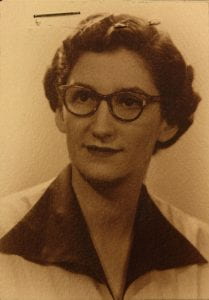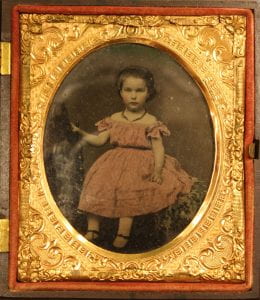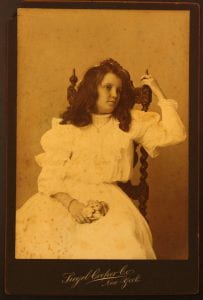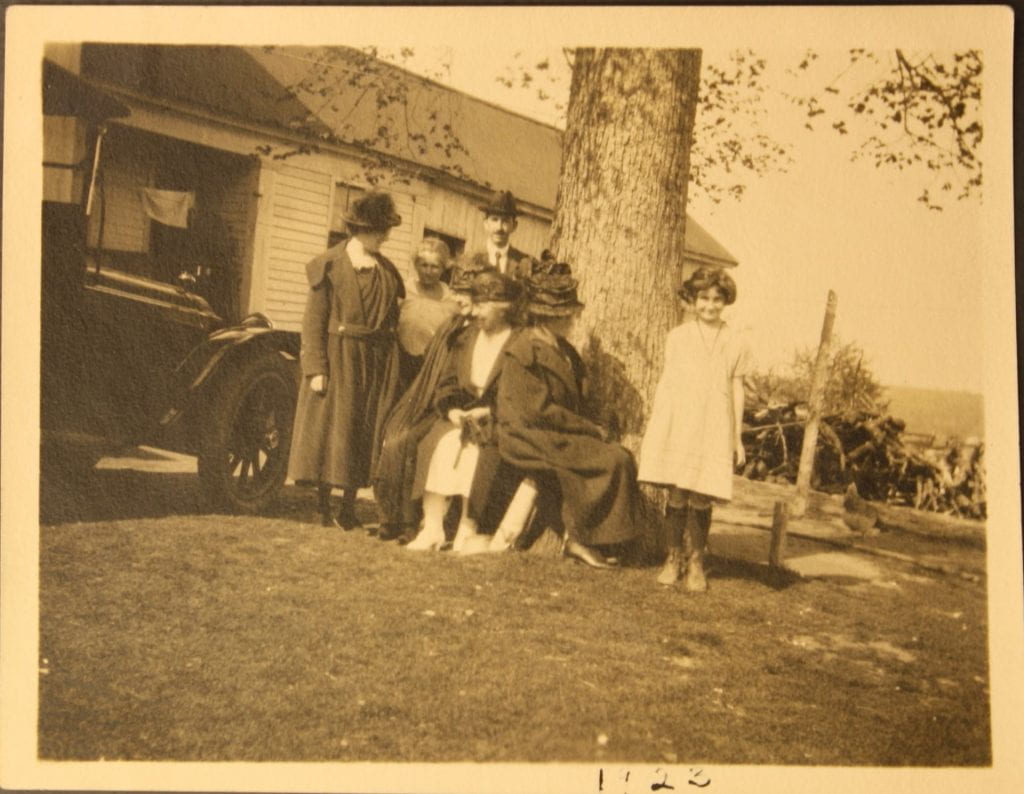Written by Helen McLallen
In the mid 1950s, Elizabeth K. Starkweather donated several dozen family garments to the Cornell Fashion + Textile Collection (CF+TC) and a group of family papers to the Cornell University Library Rare and Manuscripts Collections (RMC). Among them were three dresses, all made from the same simple and delicate red and white checked fabric, for three generations of young girls. I had to find out more. It’s not uncommon to find a garment that has been altered or updated for a later generation to wear. This particularly happens with wedding gowns. But for a dress to be remade over three generations is more unusual.
Such artifacts do not happen by chance. The exceptional quality and provenance of the fabric certainly appealed to each generation. The recycling of old clothes and fabrics for new designs has a long tradition in many societies. Most of all, the dresses imply a hope for generational connections and continuity. The preserved photographs and letters in the collection reinforce the strength of this social thread, a character that is especially noteworthy in today’s throw-away society of less durable fabrics and fast-paced fashion trends.
The donor provided some information when she gave the dresses, including the story that the fabric was originally brought from China by William Ayers, and that the dress for each subsequent generation was made using fabric of the previous generation’s dress. William Ayers was an American sea captain and Master Mariner, whose trade took him to India, China, and likely other ports in the East. According to information in the CF+TC database the fabric was a combination of silk and pina (pineapple) fiber. One of the advantages the CF+TC has is access to the department’s fiber scientists and their equipment, and I was able to consult with Sam Zeng, Research Associate in Fiber Science and Lab Manager. He tested the fabric using FTIR (Fourier-transform infrared spectroscopy) and despite some slight anomalies in the IR signature of the red the fabric appears to be entirely silk. That result is consistent with its Chinese origin.
The first dress (CF+TC No. 584) was made for William’s eldest daughter, Princess Kezia Ayers (1858-1940) in the early 1860s. It is a short sleeved fitted bodice, fully lined with muslin, with fine machine-made lace, imitating Bucks, detailing the neckline and sleeve edges. There are three square carved shell buttons remaining on the center back closure, along with several replacement buttons. The buttons seem a bit large for a five or six year old child’s dress. It’s unclear whether they are original, but they do fit through the also rather large buttonholes, and carved shell buttons were made and used in the mid-19th century. It likely had a very full, bell-shaped skirt, perhaps with tight, tiny cartridge pleats at the waist.
What a delightful and interesting name! Princess Kezia’s great-grandmother’s name was Keziah, a biblical name fairly common in Victorian England, though the source of Princess is thus far elusive. Princess Kezia was born in Lancashire, England in 1858, to her English mother, Mary Ann Kerfoot, and American father, who had married in Calcutta the year before. Shortly after her birth, the family moved back to Massachusetts and by 1873 settled in Ithaca. There she attended the Ithaca Academy, followed by Mt. Holyoke College. In 1882 she married Dr. Malcolm Leal, a homeopathic physician and an 1876 Cornell graduate.
We only have the bodice to Kezia’s dress because its skirt (and possibly some additional fabric from the original yardage) was used in making the second dress (CF+TC No. 583) for her daughter, Lucy King Leal (1886-1961). Her dress has short puffed sleeves and a blousy bodice trimmed with narrow red velvet ribbons. Under its loose appearance, however, is a fitted lining. Its skirt may have been fairly fitted through the hips, and could have been draped and slightly longer in the back. There are snipped threads inside the neckline, suggesting the removal of some type of trim. Could it have been the lace used on Elizabeth’s dress? In 1911 Lucy King Leal married Richard Holmes Starkweather, a businessman in Knoxville. The couple lived in Tennessee where both of their children were born, then later moved to Connecticut where Lucy died in 1961.
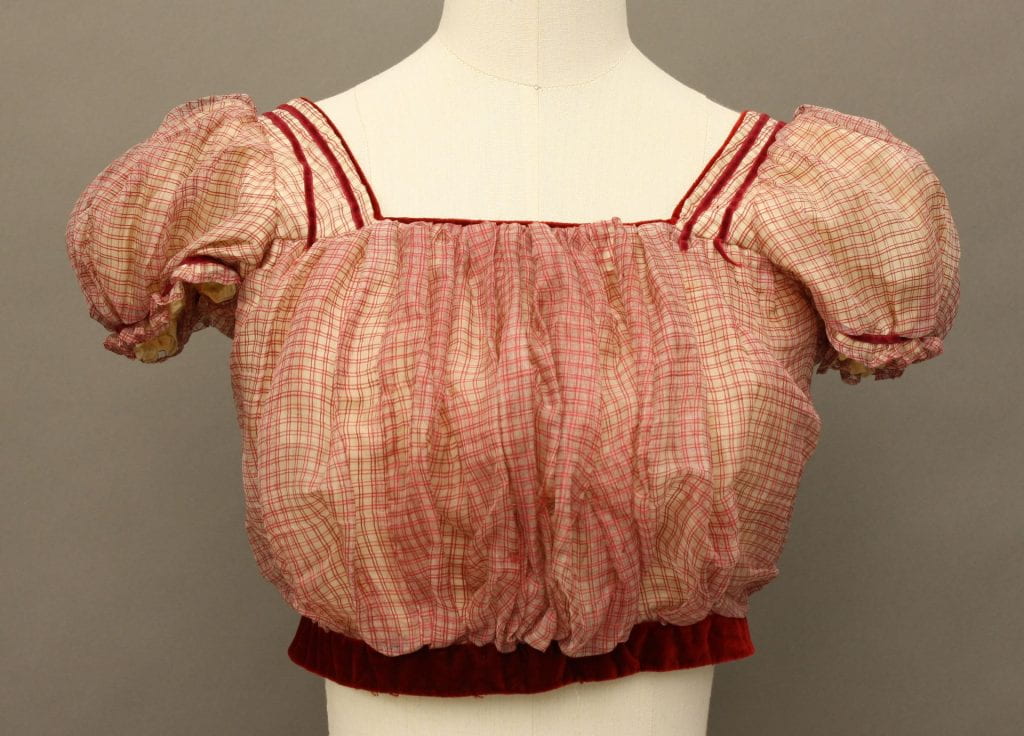
Dress bodice (CF+TC No. 583) made from the skirt of Princess Kezia Ayers’ dress for her daughter Lucy King Leal
The final dress (CF+TC No. 613) was for the donor, Elizabeth Kezia Starkweather (1914-1978). It again was made using fabric from the skirt of her mother, Lucy King Leal Starkweather’s 1890s dress. It was made in 1925, when she was about ten years old, for her to wear to a dancing class. Her dress is floaty and loose, with a much more carefree feel than her mother’s or grandmother’s. It is lined with cream colored silk, taken from the petticoat of her mother’s dress, trimmed with lace and the same narrow red velvet ribbons. This lace appears to be handmade, possibly Valenciennes as the diamond-shaped mesh is characteristic of that type. The dress is made of four lengths of the full 21” width of the fabric. While I didn’t see signs of former seam lines, there is considerably more wear visible on her dress, including a prominent fold and wear line just above the hem, and the hem is faced. Perhaps the skirt of Lucy’s dress just wasn’t long enough for a turned back hem on Elizabeth’s dress?
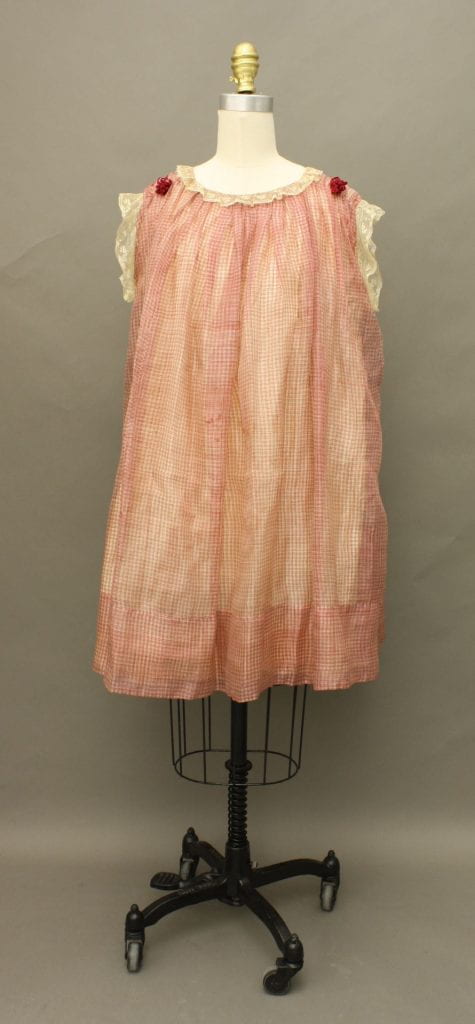
Dress (CF+TC No. 613) made from the dress of Lucy King Leal for her daughter Elizabeth Kezia Starkweather, Circa 1925
It is easy to envision a young girl twirling in this very 1920s style. That young girl grew up to become a child psychologist, receiving her M.A. in Child Psychology from the University of Iowa in 1938. Elizabeth completed her Ph.D. in Child Development and Family Relationships from Cornell’s College of Home Economics in 1957 and became a professor of child development at Oklahoma State University. She was the author of several books on child behavior and development.
This trio of dresses is but one example of the many topics that can be explored through items in the Cornell Fashion + Textile Collection. I have touched on some of them here – the sentimental attachment in reworking and saving a mother’s and grandmother’s dress, trade, labor, material identification, changing styles and silhouettes, what kind of occasions and social activities the dresses were worn for, the use of available documentary materials to supplement, as well as challenge, oral history, and the connection between the CF+TC collections and those of the RMC. The CF+TC is filled with these opportunities for research, and we invite you to visit – and use – the collection for your own explorations.
Images
- Elizabeth Kezia Starkweather; Elizabeth Starkweather Family Papers No. 1796, Rare and Manuscript Collections, Cornell University Library
- Dress bodice made for William Ayers’ eldest daughter, Princess Kezia Ayers; Cornell Fashion + Textile Collection No. 584
- Bodice button detail; Cornell Fashion + Textile Collection No. 584
- Princess Kezia Ayers, Circa 1860; Elizabeth Starkweather Family Papers No. 1796, Rare and Manuscript Collections, Cornell University Library
- Lucy King Leal, Circa 1901; Elizabeth Starkweather Family Papers No. 1796, Rare and Manuscript Collections, Cornell University Library
- Dress bodice made from the skirt of Princess Kezia Ayers’ dress for her daughter Lucy King Leal; Cornell Fashion + Textile Collection No. 583
- Dress made from the dress of Lucy King Leal for her daughter Elizabeth Kezia Starkweather, Circa 1925; Cornell Fashion + Textile Collection No. 613
- Elizabeth Kezia Starkweather (far right) and family, Circa 1923; Elizabeth Starkweather Family Papers No. 1796, Rare and Manuscript Collections, Cornell University Library
Acknowledgement
Special thanks to Elizabeth Davis, PhD (Department of Fiber Science & Apparel Design, Cornell University) for help identifying the lace on these dresses.
Bibliography
Elizabeth Starkweather Family Papers No. 1796, Rare and Manuscript Collections, Cornell University Library.
Ithaca Directory and Tompkins County Business directory for 1873-4, J. Burke Fitzgerald, Compiler and Publisher (Ithaca, N.Y.: 1873).
New York State Census, Tompkins County, Ithaca, 1875.
About the Author
Helen McLallen was the Collection Manager of the Cornell Fashion + Textile Collection for over ten years. She retired in June 2022. She earned her Masters of Arts in History Museum Studies from the Cooperstown Graduate Program in History Museum Studies and spent most of her career as a curator in county historical societies and working with community history.

